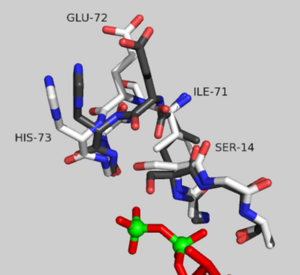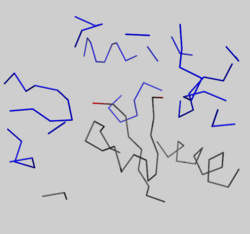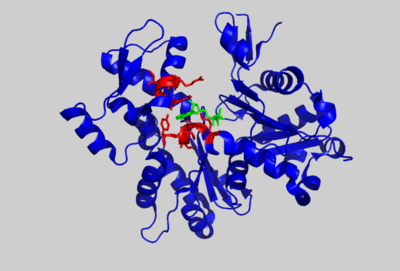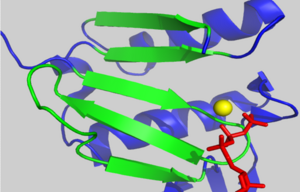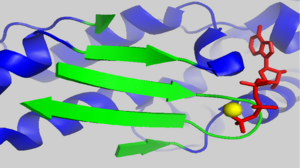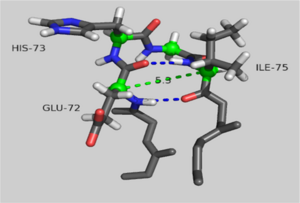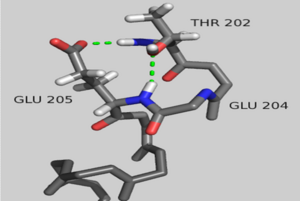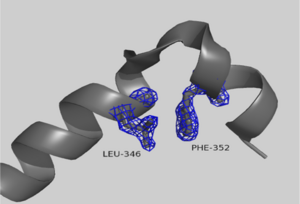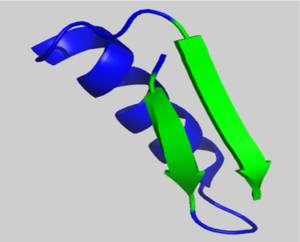Non-polymerizable monomeric actin
From Proteopedia
| Line 1: | Line 1: | ||
| - | + | <StructureSection load='2hf4' size='450' side='right' scene='User:Thomas_E_Sladewski/Sandbox_1/2hf4_blue_helix2/1' caption=''> | |
| - | + | '''Non-polymerizable monomeric actin''' or AP-actin is an Sf9-expressed cytoplasmic actin harboring two point mutations that prevent the monomer from polymerizing into actin filaments. These mutations allow for the crystallization of actin without the use of specific toxins or actin-binding proteins that may influence the structure. The crystal structure of AP-actin has been solved for the ADP-bound form (PDB entry [[2hf3]]) and the ATP-bound form (PDB entry [[2hf4]])<ref>PMID: 16920713</ref>. Alpha helices are in green. Loops and beta strands are in blue. ATP is designated with gold spheres and Ca+2 ions in red spheres. These two structures are shown below as a morph between the two states. | |
| - | + | ||
| - | '''Non-polymerizable monomeric actin''' or AP-actin is an Sf9-expressed cytoplasmic actin harboring two point mutations that prevent the monomer from polymerizing into actin filaments. These mutations allow for the crystallization of actin without the use of specific toxins or actin-binding proteins that may influence the structure. The crystal structure of AP-actin has been solved for the ADP-bound form (PDB entry [[2hf3]]) and the ATP-bound form (PDB entry [[2hf4]])<ref>PMID: 16920713</ref>. These two structures are shown below as a morph between the two states. | + | |
===Structural features of actin=== | ===Structural features of actin=== | ||
Revision as of 07:49, 8 May 2013
Non-polymerizable monomeric actin or AP-actin is an Sf9-expressed cytoplasmic actin harboring two point mutations that prevent the monomer from polymerizing into actin filaments. These mutations allow for the crystallization of actin without the use of specific toxins or actin-binding proteins that may influence the structure. The crystal structure of AP-actin has been solved for the ADP-bound form (PDB entry 2hf3) and the ATP-bound form (PDB entry 2hf4)[1]. Alpha helices are in green. Loops and beta strands are in blue. ATP is designated with gold spheres and Ca+2 ions in red spheres. These two structures are shown below as a morph between the two states.
Structural features of actinThe actin monomer, or , contains four structural domains: (residues 1-32, 70-144 and 338-375), (residues 33-69), (residues 145-180 and 270-337) and (residues 181-269). These domains can be classified as largely alpha/beta connected by loops which are shown in some structural analysis to undergo significant nucleotide dependent structural changes. The is located in domain 2 (residues 40-51). This loop is not shown in the crystal structure of AP-actin because it was found to be disordered in both the ATP and ADP-bound state. However, some studies have found this loop to be ordered in certain conditions[2]. This is discussed in more detail below. The or sensor loop is located in domain 1 (residues 70-78) and is though to contain important residues for sensing the nucleotide state. The (residues 165-172) is located in domain 3 and is important for the binding of WH2 domain-containing proteins. The (residues 11-16) and the (residues 154-161) are contained in the nucleotide-binding cleft. AP-actin is a cytoplasmic actin encoded from the Drosophila melanogaster 5C actin gene. It shares 98.7% sequence homology with human γ-cytoplasmic actin. AP-actin contains two point mutations, that render it incapable of polymerizing into actin filaments. These mutations were shown to have little effect on ATP hydrolysis or long range structural changes.
Nucleotide-dependent structural changes in the nucleotide-binding cleft of AP-actin
Structural changes between the ATP and ADP-bound state of are confined to the active site. The of the two states outside the sensor loop region superimpose very well, with a RMSD of 0.19 angstroms. A close-up of the reviles how binding ATP elicits structural changes in the nucleotide-binding cleft that is propagated to the sensor loop. When actin is bound to ADP, the serine-14 side chain forms a hydrogen bind with the beta phosphate ADP. Upon ATP binding, the gamma phosphate sterically clashes with the oxygen of serine-14, forcing the hydroxyl to rotate 130°. The displaced serine residue impinges on the backbone carbonyls of residues isoleucine-71 and glutamic acid-72 in the sensor loop. This causes a 180° rotation of the peptide linkage between glutamic acid-72 and histidine-73. These structural changes impact residues proximal to the sensor loop. Transition to the ATP-bound state causes glutamic acid-72 to form a new hydrogen bond with threonine-77. This induces a reorientation of . ATP binding also disrupts hydrogen bonding between arginine-183 and residues 72 and 73 of the sensor loop causing a conformational change of . Aspartic acid-179 stacks against histidine-73 in the ATP-bound state which induces a shift in the position of to improve salt bridge formation with aspartic acid-179. In the AP-actin structure, changes in conformation due ATP binding are local to the active site and do not appear to propagate into domains.
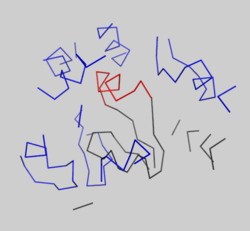 Crystal packing interactions between ADP-actin, complexed with TMR (grey ribbon)(PDB entry 1J6Z) and neighboring residues in subdomain 2 of an adjacent monomer in the crystal within 15 angstroms of the D-loop in the unit cell (blue ribbons). Residues 39-50 are shown in red.
The D-loopThere is some controversy over whether or not the D-loop undergoes structural changes upon actin binding ATP. In the structure of AP-actin, the D-loop is disordered in both the ATP and ADP-bound state. Also, there is no evidence that structural changes in the nucleotide binding cleft propagate to subdomain 2. This argues that the D-loop remains disordered in both states. However, other groups show large ATP-dependent structural changes in the D-loop[2]. This is illustrated, right, in a subdomain 2 morph of actin complexed with tetramethylrhodamine (TMR) in the ADP-bound state, (PDB entry 1J6Z) and actin complexed with DNAase I in the ATP-bound state, (PDB entry 1ATN)[2]. These structures revile that the D-loop is disordered when actin is bound to ATP, and transitions to an alpha-helix in the ADP-bound state. It has been suggested that the alpha helix in the ADP-bound state results from crystal packing. In support of this, actin complexed with TMR in the ADP state shows extensive neighboring contacts around the D-loop (shown left, lower panel). In contrast, AP-actin, (PDB entry 2HF3), shows far fewer crystal contacts around the D-loop (shown left, upper panel). These crystal contacts have been proposed to result in the nucleotide-dependent structural changes in the D-loop observed in some structures. In further support of this, the sequence of the D-loop, HQGVMVGMG, has a low propensity to form an alpha helix. However, molecular dynamic simulations show that the D-loop favors the alpha helix conformation in the ADP state, and not the ATP or ADP-Pi states [3]. This study supports a model where small perturbations in the active site shift the equilibrium of the D-loop between the flexible coil and helix state. Further studies are needed to resolve this question.
The actin fold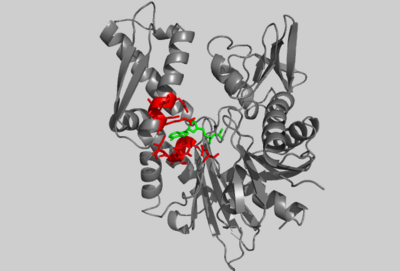 Crystal structure of the amino-terminal 44K ATPase fragment of the 70K bovine Hsc70 protein, (PDB entry 3HSC), bound to ADP. Selected residues are shown in red. ADP is shown in green. 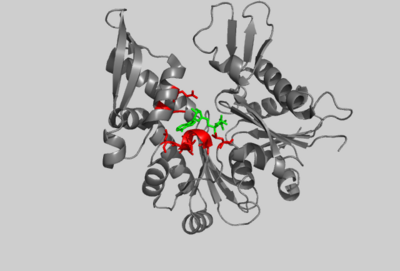 Crystal structure of MreB from Thermotoga Maritima bound to AMP.PNP, (PDB entry 1JCG). Selected residues are shown in red. AMP.PNP is shown in green. Through structural comparisons, it’s possible to identify evolutionary relationships among proteins with common folds. The core structure of actin is strikingly similar to the structure of Hsc70 and MreB which both bind ATP with a common motif. Hsc70 is a member of the 70-kDa heat-shock family Hsp70 which binds to unfolded proteins and hydrolyzes ATP. Exchange factors recycle Hsc70 by stimulating ATPase activity thereby mediating dissociation from the protein substrate[4]. On the right, the crystal structure of a 44-kDa amino-terminal fragment of Hsc70 (PDB entry 3HSC) is shown that retains ATPase activity but is incapable of binding proteins[5]. AP-actin, in blue, is shown aligned to this structure with functionally and structurally conserved residues in red. Subdomains 1 and 3 of actin are composed of a five-stranded β-sheet surrounded by α-helicies. These domains are highly conserved in Hsc70. The interface between subdomains 1, 3, and 4 are required in both structures to bind nucleotide. The adenosine group of ATP fits into a hydrophobic pocket between subdomains 3 and 4, formed by two helices (AP-actin: residues 210-214, 302-306, 336 and Hsc70: residues 268-272, 339-343, 366 as shown in red for both structures). The ribose is bound by Glu214 in actin and Glu268 in Hsc70. These residues form salt bridges with adjacent arginines in both structures. A comparison of these two structures shows that not only is the nucleotide binding cleft conserved but also helix packing against β-sheets in subdomains 1 and 3. This same mode of structural conservation is described for hexokinase and glycerol kinase[6]. While Hsp70 and sugar kinases show ~50% sequence identity, the bacterial cytoskeletal protein MreB shares less than 15% sequence identity. However, a comparison of the crystal structures of actin and MreB reveals high structural homology. Like actin, MreB contains two domains composed of a five-stranded β-sheet. These domains are connected by a helix, similar to actin. Subdomains 2 and 4 in actin are more diverse in the actin superfamily and share little structural homology with Hsp70 and sugar kinases. Remarkably, MreB shares the same topology as actin in these domains[7]. MreB can be superimposed on actin (PDB entry 1ATN) with an r.m.s. deviation of 3.7 Å over 310 C atoms[8]. Also, MreB can be superimposed on Hsp70 (PDB entry 1HPM) with an r.m.s. deviation of 3.4 Å over 299 C atoms. However, Hsp70 has a large insert in subdomain 4 not present in actin or MreB. This result suggests that MreB is closely related to Hsp70. Shown right is a crystal structure of MreB (PDB entry 1JCG) bound to AMP.PNP and aligned with AP-actin. Structurally conserved residues corresponding to those in actin are indicated in red. They include residues at the interface between subdomains 1 and 3, and a functionally conserved glutamic acid at position 204. This residue in MreB forms a salt bridge with an adjacent lysine residue similar to glutamic acid 214 in actin and glutamic acid 268 in Hsc70. The presence of a structurally conserved ATP-binding motif in the actin superfamily and MreB suggests that these proteins are likely the result of divergent evolution from a common ancestor. Supersecondary structure of AP-actinThe actin fold consists of a two five-stranded β-sheets surrounded by 3 helices. These sheets are present in subdomain 1 and subdomain 3 and consist of both parallel and antiparallel β-strands. Two β-strands in subdomain 1 form a β-hairpin (residues 8-21), shown left. The loop connecting the two β-strands is the S-loop which contains serine 14, a critical residue that responds to changes in bound nucleotide. Two β-strands within the subdomain 3 β-sheet also form a β-hairpin (residues 150-166), shown left. The loop connecting the β-strands form the G-loop which contain residues in the nucleotide-binding cleft. These β-sheet structures are highly conserved in the actin superfamily and contain residues critical for nucleotide binding and catalysis. Residues 70-77 in subdomain 1 make up the H-loop. This loop is also known as the sensor loop because structural changes in the nucleotide binding cleft, such as tortional movement of serine 14, are propagated to these amino acids. Thus, the H-loop undergoes the largest nucleotide-dependent conformational changes as seen above. The H-loop is a good example of a type I’ β-turn, shown right. β-turns are comprised of four consecutive residues whose distance between the α-carbons of residue i and i+3 is less than 7 Å. Typically, β-turns form hydrogen bonds between the carboxyl group of residue i and the amide group of residue i+3. Here, the carbonyl of glutamic acid-72 (i) forms a hydrogen bond with the amide group of isoleucine 75 (i+3). In addition, another hydrogen bond is formed between the carbonyl of isoleucine 75 and the amide of glutamic acid 72, indicating a capping box motif. β-turns can be further classified by the dihedral angles of the i+1 and i+2 residues as well as the distance between the α-carbons of residue i and i+3. This turn is consistent with a type I’ β-turn. Helix capping describes the interruption of hydrogen bonds between amide hydrogen’s and carbonyl oxygen’s at the termini of an α-helix. This occurs when amide hydrogen’s form hydrogen bonds with alternative binding partners such as side chains. A number of helix capping motifs have been described to form these alternative hydrogen bonding patterns. The N-terminus of α-helix eight (residues 202-217) in AP-actin is capped by a “capping box” motif. This motif caps two (threonine-202 and glutamic acid-205) of the initial four amide hydrogen donors in the helix, shown left. [9] Domain 1 in actin contains a helix-loop-helix motif (residues 333-357), shown right. The helices are interrupted by loop residues 346-352. The break in helicity appears to be due to two glutamates (Q353 and Q354) that hydrogen bind with the carbonyl carbons of adjacent residues in the helix (L349, A347 and T351). In addition to this, there appears to be a hydrophobic staple between residues L346 and F352 However, this doesn’t follow the i, i+5 rule that is normally seen with a hydrophobic staple. Subomain 1 contains a right handed β-α-β motif (residues 103-136). Shown left, two parallel β-strands are linked by an α-helix. These β-strands are part of the β-sheet motif in subdomain 1. See AlsoReferences
| ||||||||||||||||||||||||||||||
